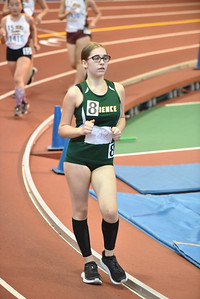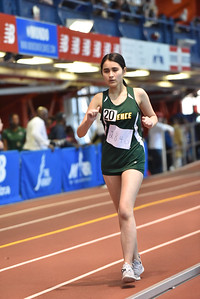The Unsung Sport of Racewalking
What started as English gentry betting on footmen has made it to the Olympics, but it might just be the most obscure event broadcasted during every Olympic Games.

Zoe Stanley ’23 racewalks during the 2019 winter track season at the Armory.
It’s a conundrum: a track event, where running gets you disqualified. Most people only know it as a “weird way of racing on foot.” The rules are fairly simple; you should keep the leg coming down to touch the track straight, and keep one foot on the ground at all times.
Racewalking has been an Olympic event for over a century. However, despite the international platform, it’s not well-practiced on the regional level. In the United States, a nation that patronizes many different and unique sports, there are no racewalking leagues, nor are there any college scholarships available to high school racewalkers.
But where did the sport come from?
Racewalking originated in Victorian England between the late 19th and early 20th centuries, where various nobles travelling together would bet on their footmen to see who could walk the fastest wherever the group was travelling. This form of racing while walking — originally called ‘pedestrianism’ — spread in popularity among the general public, until it emerged in other countries too, making its way to the United States in the early 20th century. It was first introduced as an Olympic sport at the 1908 Summer Olympics in London, where the two events held were exclusively for men, with distances of 20k and 50k; in 1960 a women’s 20k was added. Starting with the 2024 Paris Games, there will only be two events: a 20k for men and a 20k for women.
The most-used muscles when racewalking are the hamstrings and shins, which are muscles the human body doesn’t normally depend on to move. In contrast with other track athletes, racewalkers must have equally impeccable stamina and technique. It’s a distance event, so practices take lots of time, and similarly to sprinters, racewalkers must warm up extensively to prevent the risk of injury. Some of these common injuries include shin splints (microtears in shin muscles) and pulled hamstrings (hamstring muscles stretched too far), in addition to hip issues. All of these injuries are alarming, but they can be avoided when the proper time and training routines are implemented.

Zoe Stanley ’23 has racewalked since her ninth grade year, and the only injury that she experienced was in her knees. It was “bad enough that I thought I might have to take the season off,” she explained, “but I started running more once the pandemic started, and they haven’t bothered me since.” Stanley has gone on to place in the top three at each track meet in which she walked, and she has been appointed as the captain of the track team.
Here at Bronx Science, racewalking is one of twenty-four PSAL track and field events offered during both the winter and spring seasons; last spring, Bronx Science had the largest racewalking team, with a grand total of five competitors. Unfortunately, there is currently no boy’s team.
The racewalking team at Bronx Science is looking for new members. If you’re interested in trying it out, contact Zoe Stanley at stanleyz@bxscience.edu.
It’s a conundrum: a track event, where running gets you disqualified.
Felicia Jennings-Brown is a Copy Chief for ‘The Science Survey.’ What she appreciates the most about journalistic writing is its use as a channel to...
